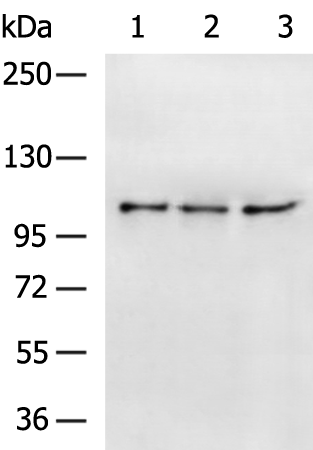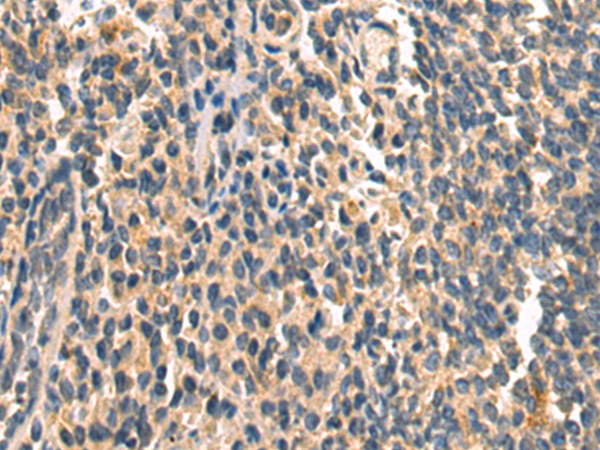

| WB | 咨询技术 | Human,Mouse,Rat |
| IF | 咨询技术 | Human,Mouse,Rat |
| IHC | 1/50-1/100 | Human,Mouse,Rat |
| ICC | 技术咨询 | Human,Mouse,Rat |
| FCM | 咨询技术 | Human,Mouse,Rat |
| Elisa | 1/5000-1/10000 | Human,Mouse,Rat |
| Aliases | XT1; XTI; XT-I; DBQD2; XYLTI; PXYLT1; xylT-I |
| WB Predicted band size | 108 kDa |
| Host/Isotype | Rabbit IgG |
| Antibody Type | Primary antibody |
| Storage | Store at 4°C short term. Aliquot and store at -20°C long term. Avoid freeze/thaw cycles. |
| Species Reactivity | Human, Mouse, Rat |
| Immunogen | Synthetic peptide of human XYLT1 |
| Formulation | Purified antibody in PBS with 0.05% sodium azide and 50% glycerol. |
+ +
以下是关于XYLT1抗体的3篇参考文献,按文献名称、作者和摘要内容简要概括:
1. **文献名称**: "Xylosyltransferase-I regulates glycosaminoglycan synthesis during human pathologic myofibroblast differentiation"
**作者**: Schröder, H., et al.
**摘要**: 研究探讨XYLT1在病理性肌成纤维细胞分化中的作用,开发特异性抗体验证其表达水平与糖胺聚糖合成的关联,揭示其在纤维化疾病中的功能调控。
2. **文献名称**: "Antibody-based profiling of xylosyltransferase isoforms in cancer cell lines"
**作者**: Pacheco, C.R., et al.
**摘要**: 通过生成单克隆抗体区分XYLT1和XYLT2亚型,应用于多种癌细胞系的蛋白质印迹分析,发现XYLT1在乳腺癌中显著上调,提示其作为潜在生物标志物的价值。
3. **文献名称**: "Loss of xylosyltransferase 1 drives primary cilia dysfunction in polycystic kidney disease"
**作者**: Czajka, A., et al.
**摘要**: 利用XYLT1抗体进行免疫荧光定位,发现XYLT1缺失导致纤毛结构和信号异常,阐明了其在多囊肾病中的机制,为治疗干预提供新靶点。
4. **文献名称**: "Functional characterization of XYLT1 mutations in Ehlers-Danlos syndrome"
**作者**: Götting, C., et al.
**摘要**: 通过患者来源的成纤维细胞和特异性抗体检测,揭示XYLT1突变导致酶活性降低及细胞外基质异常,解释其在埃勒斯-当洛综合征中的病理作用。
这些文献覆盖了XYLT1抗体在疾病机制、亚型分析和临床诊断中的应用,可根据研究需求进一步查阅原文。
XYLT1 (xylosyltransferase 1) is a key enzyme involved in the biosynthesis of proteoglycans, which are critical components of the extracellular matrix. It catalyzes the initial step in glycosaminoglycan (GAG) chain formation by transferring xylose from UDP-xylose to specific serine residues on core proteins, a process essential for the assembly of heparan sulfate and chondroitin sulfate chains. These GAG-modified proteoglycans regulate diverse cellular processes, including cell adhesion, signaling, and tissue morphogenesis. As a type II transmembrane protein localized in the Golgi apparatus, XYLT1’s activity is tightly linked to connective tissue homeostasis, and its dysregulation has been implicated in genetic disorders like Desbuquois dysplasia and connective tissue pathologies.
XYLT1 antibodies are vital tools for studying its expression, localization, and function in both physiological and disease contexts. Commercially available as monoclonal or polyclonal variants, these antibodies are widely used in techniques such as Western blotting, immunohistochemistry, and immunofluorescence. Research has highlighted XYLT1’s role in fibrosis, cancer progression (e.g., breast and liver cancers), and osteoarthritis, where its overexpression correlates with abnormal extracellular matrix remodeling. Additionally, XYLT1 is explored as a potential biomarker for disease severity or therapeutic targeting. Studies also suggest its involvement in TGF-β signaling and mechanotransduction pathways, emphasizing its broader impact on cellular behavior. Validated antibodies against XYLT1 thus support investigations into tissue development, regenerative medicine, and pathogenesis of matrix-related diseases.
×